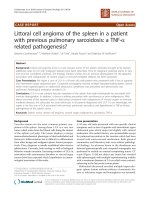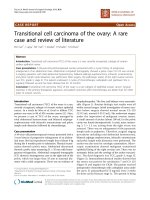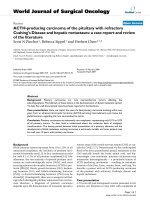Báo cáo khoa học: "Adenoid cystic carcinoma of the peripheral lung: a case report" potx
Bạn đang xem bản rút gọn của tài liệu. Xem và tải ngay bản đầy đủ của tài liệu tại đây (780.17 KB, 4 trang )
CAS E REP O R T Open Access
Adenoid cystic carcinoma of the peripheral lung:
a case report
Masahiro Kitada
1*
, Keisuke Ozawa
1
, Kazuhiro Sato
1
, Satoshi Hayashi
1
, Yoshihiko Tokusashi
2
, Naoyuki Miyokawa
2
,
Tadahiro Sasajima
1
Abstract
Adenoid cystic carcinoma of the peripheral lung is a rare entity. We recently encountered a patient with adenoid
cystic carcinoma. A 75-year-old woman sho wed a nodular lesion with 10 mm in diameter in the right upper lung
field on chest radiography. The diagnosis was unclear, but lung cancer could not be ruled out. Thoracoscopic
biopsy was performed, and intraoperative pathological diagnosis revealed the carcinoma of the lung. We enforced
upper lobectomy and mediastinal lymph node dis section to the patient. Histopathological examination revealed
adenoid cystic carcinoma with a characteristic cribriform structure. Immunohistochemical examination revealed that
the tumor cells were positive for thyroid transcription factor 1 (TTF-1), this tumor was diagnosed primary ACC of
the lung.
Background
Adenoid cystic c arcinom a (ACC) of the lun g is a rela-
tively rare lung cancer arising from the bronchial glands
and accounting for about 0.04-0.2% of all lung cancers
[1,2]. ACC has a slow growing and prolonged clinical
course, and thus is considered a low-grade malignancy.
The site of origin is the tracheobronchial glands, so
ACC is more common in the central bronchi than in
the segmental bronchi. Reports of ACC originating in
the peripheral lung are rare. In addition, in cases of
occurrence in the periphery, lung metastases from a sali-
vary gland tumor must be ruled out. It reports a case of
ACC which we experienced.
Case
A75-year-oldwomanshowedanodularlesioninthe
right upper lung field on the chest radiography with 6
mm diameter. After 1 yea r of observa tion, follow-up
chest radiogra phy showed an increase in size to 10 mm.
In the thorough examination of the bronchoscope, the
definitive diagnosis wasn’t on, so the patient was intro-
duced to our department for diagnosis and treatment.
Past medical history included hypertension and dia-
betes mellitus treated with oral medications. In addition,
a salivary gland tumor had been resected 19 years ago,
but details were unknown. Family history was unre-
markable, and she had nev er been a smoker. Her height
was 149 cm, the weight was 44 kg, hers blood pressure
was 135/91 mmHg and hers heart rate was 65 beats/
min (normal sinus rate). She had no abnormal findings
during the physical examination. The biochemical exam-
ination of blood did not revealed abnormalities, and
levels of tumor markers carcinoembryonic antigen
(CEA) was 2.9 ng/ml, squamous cell carcinoma antigen
(SCC) was 0.6 ng/ml, Cyf ra21-1/cytokeratin 19 fragment
(CYFRA) 0.96 ng/ml, and neuron-specific enolase (NSE)
was 3.2 ng/ml.
Pulmonary function tests showed that vital capacity
(VC) was 2520 ml, percentage of predicted VC was
117.8%, forced expiratory volume in 1 s (FEV1) was
1780 ml, and percentage of predicted FEV1 was 74.2%.
Chest radiography revealed a well circumscribed,
rounded tumor nodule in the right upper lung field (Fig.
1). Chest computed tomography (CT) demonstrated a
partially serrated border solid nodule 10 mm in dia-
meter nodular in the right S1 region (Fig. 2). On
bronchoscopy, no abnormalities were seen in the visua-
lized area, and cytology revealed no malignant cells.
Malignancy could not be excluded based on these find-
ings and including increasing size, so surgery was
planned.
* Correspondence:
1
Department of Surgery, Asahikawa Medical University, Midorigaoka-Higashi
2-1-1-1 Asahikawa Hokkaido 078-8510, Japan
Full list of author information is available at the end of the article
Kitada et al. World Journal of Surgical Oncology 2010, 8:74
/>WORLD JOURNAL OF
SURGICAL ONCOLOGY
© 2010 Kitada et al; licensee BioMed Central Ltd. This is an Open Access article distributed under the terms of the Creative Commons
Attribution License ( which permits unrestricted use, distribution, and reproduction in
any medium, provided the original work is properly cited.
A mini thoracotomy was made in the 5th intercostal
space, and the mass was biopsied under video-assisted
thoracoscopic surgery. Intraoperative pathological diag-
nosis showed mucinous carcinoma. Standard upper
lobectomy and mediastinal lymph node dissection
(ND2a) was performed. The macroscopic specimen (Fig.
3) showed a 1 5-mm (maximum diameter) mass with a
nearly uniform internal structure. Histopathological
examination ( Fig. 4) with hematoxylin and eosin (HE)
staining showed ACC with a cribriform structure and
mucinous component. On immunohistochemical analy-
sis, these tumor cells were positive for TTF-1(Fig. 5
(×100) and Fig. 6 (×400). This tumor was diagnosed pri-
mary ACC of the lung and p-T1N0M0 stage 1A.
Because of surgical margin was free, it didn’tdoradio-
therapy and chemotherapy. Postoperative course was
satisfactory, and the patient was discharged on hospital
day 12. At present, as of 2 years a fter surgery, no signs
of recurrence have been identified.
Discussion
ACC of the lung is a malignant tumor arising in the tra-
cheobronchial glands distributed in the airway submu-
cosa, with a morphology similar to ACC arising in the
salivary glands. In general, as with typical carcinoid and
mucoepidermoid tumors, this lung tumor shows low
grade malignancy. ACC repres ents 0.04-0.2% of all lung
cancers [1,2], and >90% arise in the central rather than
segmental b ronchi, thus accounting f or the small num-
ber of reported cases in the peripheral lung [3]. ACC in
the peripheral lung must therefore be distinguished
from metastatic lung tumor.
Our patient had undergone resection of a salivary
gland tumor 19 years previously, although the details
are unknown. Metastatic lung tumor therefore had to be
ruled out. For this purpose, immunostaining for TTF-1
is useful to diagnose a lung primary lesion. TTF-1 is
highly sensitive and specific for diagnosis of primary
Figure 1 Chest radiography showing a nodular shadow in the
upper lung field.
Figure 2 Chest CT showing the tumor, 10 mm in diameter, in S1.
Kitada et al. World Journal of Surgical Oncology 2010, 8:74
/>Page 2 of 4
lung cancer. TTF-1 is a transcription factor specifically
expressed in the thyroid and lung, and is expressed in
60-70% of pulmonary adenocarcinomas. TTF-1 is
expressed in follicular epithelial ce lls of the thyroid, and
in type II alveolar epithelial cells and Clara cells of the
lung. TTF-1 is expressed in pulmonary adenocarcino-
mas, but not in metastatic lung tumors (except thyroid
tumor metastases), so this marker is useful to distin-
guish between primary and metastatic lesions [4,5]. In
our patient, TTF-1 was positive and no thyroid lesions
were present, thus establishing a final diagnosis of
primary lung cancer.
The first-line treatment for ACC is surgical resection.
As ACC often arises in the central airways, tracheo-
bronchoplasty i s a lso often indicated [6,7]. In addition,
although the tumor may appear localized, the resection
margins may show positive results for tumor cells due
to widespread invasion along the airway. However,
radiation sensitivity is relatively high, so radiotherapy
may be useful [7,8]. Similarly, bronchial submucosal
progression may be present even in peripheral lesions,
so intraoperative pathological diagnosis has been recom-
mended. In this ACC, the tumor showed a small
diameter and seemed completely resectable, so intrao-
perative pathological diagnosis was not performed for
Figure 3 Macroscopic findings showing a tumor with clear boundaries, a uniform 10 mm in diameter.
Figure 4 Histological findings showing typical cribriform
pattern and constituent cells including of bronchial epithelial
cells, myoepithelial cells, and basal cells (HE ×400).
Figure 5 Immunohistochemical examination revealed that
tumor cells were positive for TTF-1 (×100).
Kitada et al. World Journal of Surgical Oncology 2010, 8:74
/>Page 3 of 4
the bronchial margins. Bronchial margins of the resected
specimen p roved negative for malignant cells, but eva-
luation should probably be performed for similar cases
in future. In addit ion, because ACC is a low grade
malignancy, long term survival can be expected. How-
ever, recurrences after ≥10 years are not uncommon, so
careful follow-up observation is mandatory.
Consent statement
Informed consent was obtained from the patient for
publication of this case report and accompanying
images. A copy of the written consent is available for
review by the Editor-in-Chief of this journal.
Author details
1
Department of Surgery, Asahikawa Medical University, Midorigaoka-Higashi
2-1-1-1 Asahikawa Hokkaido 078-8510, Japan.
2
Department of Clinical
Pathology, Asahikawa Medical University, Midorigaoka-Higashi 2-1-1-1
Asahikawa Hokkaido 078-8510, Japan.
Authors’ contributions
MK have operated this case and analyzed all data. KO, KS, SH did the
assistant of the operation. YT and NM diagnosed the pathology of this case.
TS was the professor of the surgical science and had a guide.
Competing interests
The authors declare that they have no competing interests.
Received: 31 March 2010 Accepted: 26 August 2010
Published: 26 August 2010
References
1. Travis WD, Travis LB, Devesa SS: Lung cancer. Cancer 1995, 75:191-02.
2. Kawashima O, Hirai T, Kamyoshihara M, Ishikawa S, Morishita Y: Primary
adenoid cystic carcinoma of the lung: report of two cases and
therapeuticconsiderations. Lung Cancer 1988, 19:211-7.
3. Inoue H, Iwashita A, Kanegae H, Higuchi K, Fujinaga Y, Matsumoto I:
Peripheral pulmonary adenoid cystic carcinoma with substantial
submucosal extension to the proximal bronchus. Thorax 1991, 46:147-8.
4. Berghmans T, Paesmans M, Mascaux C, Martin B, Meert AP, Haller A,
Lafitte JJ, Sculier JP: Thyroid transcription factor 1–a new prognostic
factor in lung cancer: a meta-analysis. Ann Oncol 2006, 16:1673-6.
5. Jagirdar J: Application of immunohistochemistry to the diagnosis of
primary and metastatic carcinoma to the lung. Arch pathol Lab Med 2008,
132:386-96.
6. Yokouchi Hiroshi, Otsuka Yoshinori, Takemoto Norihiro, Ito Kiyotaka,
Uchida Yoshizaki, Okamoto Kenzo, Nishimura Masaharu, Kimura Kiyonobu,
Kaji Hiroshi: Primary peripheral adenoid cystic carcinoma of the lung and
literature comparison of features. The Japanese Society of Internal Medicine
2007, 46:1799-03.
7. Grillo HC, Mathisen DJ: Primary Tracheal tumors: treatment and results.
Ann Thorac Surg 1990, 49:69-77.
8. Kanematsu Takanori, Yohena Tomofumi, Uehara Tadashi, Ushijima Chie,
Asoh Hiroshi, Yohino Ichiro, Ichinode Yokito: Treatment outcome of
resected and nonresected primary adenoid cystic carcinoma of the lung.
Ann Thorac Cardiovasc Surg 2002, 8:74-77.
doi:10.1186/1477-7819-8-74
Cite this article as: Kitada et al.: Adenoid cystic carcinoma of the
peripheral lung: a case report. World Journal of Surgical Oncology 2010
8:74.
Submit your next manuscript to BioMed Central
and take full advantage of:
• Convenient online submission
• Thorough peer review
• No space constraints or color figure charges
• Immediate publication on acceptance
• Inclusion in PubMed, CAS, Scopus and Google Scholar
• Research which is freely available for redistribution
Submit your manuscript at
www.biomedcentral.com/submit
Figure 6 Immunohistochemical examination revealed that
tumor cells were positive for TTF-1(×400).
Kitada et al. World Journal of Surgical Oncology 2010, 8:74
/>Page 4 of 4









